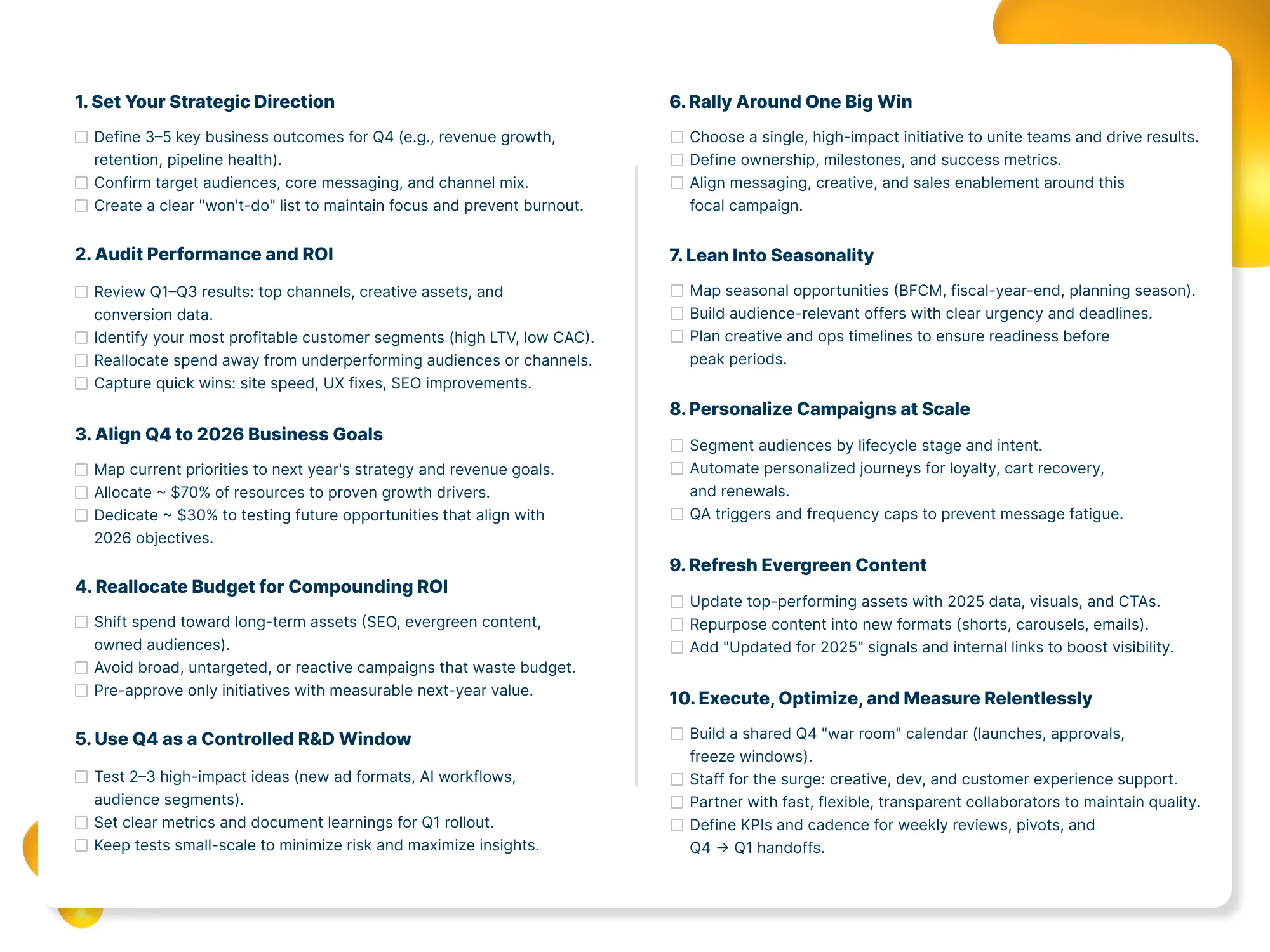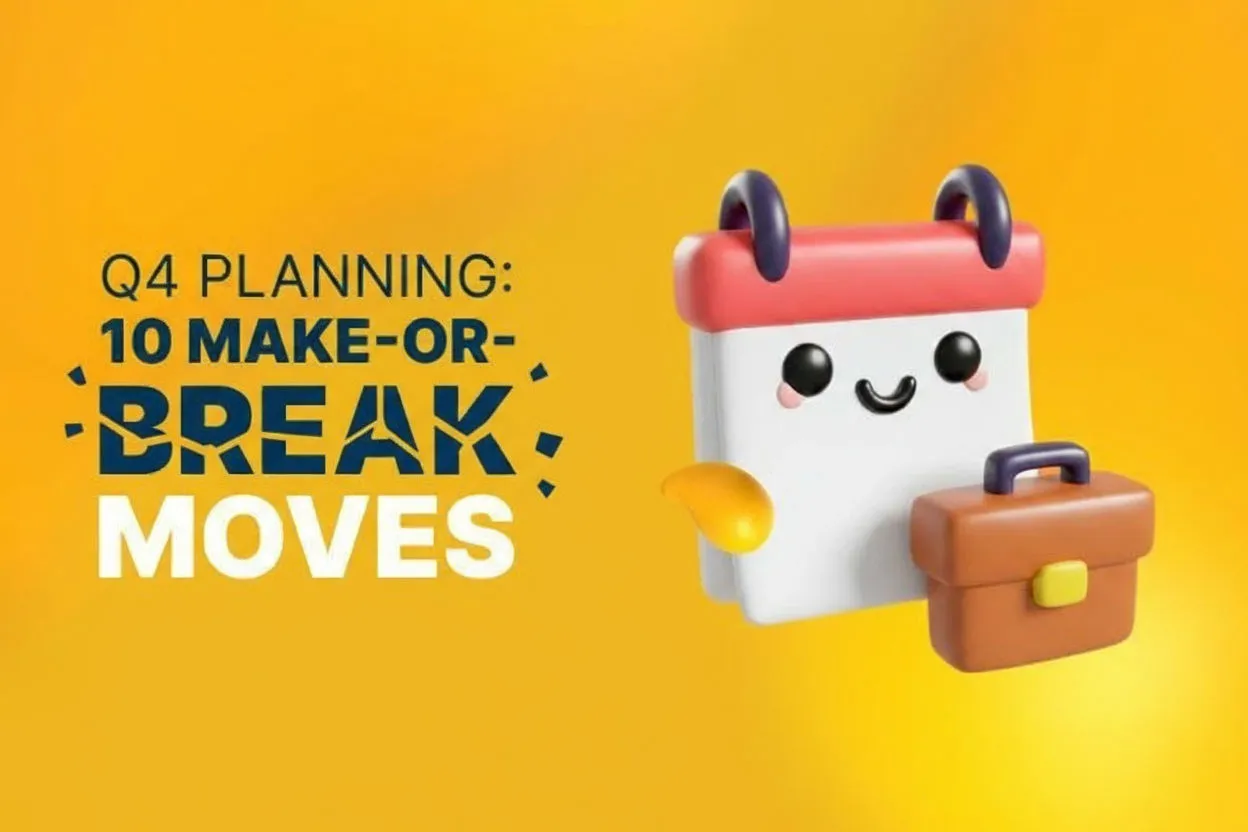Q4 doesn’t just test your marketing strategy — it tests your leadership.
Campaigns are colliding, budgets are shrinking, and leadership wants results yesterday.
What’s worse?
The “quarter” ahead often feels more like a three-week sprint to the finish.
For creative and marketing leaders, this isn’t just about closing out the year; it’s about shaping the momentum that will define 2026.
In this guide, we’ll share 10 Q4 planning strategies (plus a quick checklist) to help you focus your energy, rally your team, and turn end-of-year pressure into your most productive season yet.
Keep Exploring:
- Is a creative partner with flexible, transparent plans on your wishlist? Consider it granted! Designity’s pricing plans are built for CMOs who want quality creative without the agency overhead.
- While you’re at it, dig into 10 Thanksgiving marketing tips that’ll help your brand stand out before the holiday rush.
Q4 Planning: 10 Steps to Design a Winning Quarter & 2026
These 10 strategic planning steps will help you cut through the noise, focus your team on what matters most, and use Q4 as a launchpad for sustainable growth in 2026:
1. Set Your Strategic Direction
Before you dive into campaign calendars and creative brainstorms, stop and zoom out.
Every winning quarter starts with clarity — not activity.
Without a defined direction, even the most talented teams end up chasing shiny objects instead of measurable outcomes.
Think of Q4 as your alignment checkpoint. What 3–5 business outcomes actually matter right now — revenue growth, retention, brand strength, pipeline health? Define them early.
Then, lock in your target audiences, priority messages, and channel mix, and just as importantly, create your “won’t-do” list to protect focus and prevent burnout.
For example, if you’re a brand manager planning a multi-channel Q4 campaign, set one clear goal like increasing retention among mid-tier customers by 15%.
That direction you set informs everything: refining email segmentation, shifting paid media spend toward brand loyalty campaigns, and simplifying creative to reinforce value for returning customers.
The clarity eliminates noise, aligns every team, and ensures your team’s effort translates directly to outcomes.
2. Audit Your Performance and ROI
Before planning new campaigns, pause and look back.
A sharp Q4 strategy starts with knowing what actually worked in Q1–Q3, and who it worked for.
Review your top-performing channels, creative assets, conversion paths, and customer segments to pinpoint where your real profit came from.
Identify your most valuable consumer groups, the ones driving the highest LTV, lowest acquisition cost, or strongest retention, and double down on them this quarter.
Trim the fat elsewhere.
Reduce budget leakage from underperforming audiences, channels, or creative that no longer converts. Every dollar should ladder up to your most profitable customer base.
Don’t forget the quick wins, too: improve page speed, fix UX friction, and close SEO gaps that might be costing you conversions.
3. Align Q4 to 2026 Business Goals
Don’t look at Q4 in isolation — it’s the bridge between where you are now and where you want to be in 2026.
But this quarter isn’t about starting from scratch. It’s about doubling down on what’s already driving growth while carving out just enough space to test what’s next.
A strong rule of thumb:
- 70% of your Q4 efforts should go toward proven strategies like the channels, campaigns, and customer segments delivering the highest ROI.
- The remaining 30% is your innovation zone. It gives you a chance to test new ideas, messages, or audiences that align with your 2026 direction. More on that later.
For example, a CMO at a SaaS company might keep the bulk of Q4 focused on nurturing high-performing enterprise accounts while testing fresh messaging for a new mid-market audience they plan to scale next year.
4. Reallocate Budget for Compounding Returns
Q4 can trigger “use it or lose it” panic, but fast doesn’t have to mean wasteful.
Instead of pouring leftover spend into broad, untargeted, or reactive campaigns that waste budget, invest in assets that keep compounding value into next year, from high-performing paid channels to SEO improvements, evergreen content, owned audiences, and product education.
In other words, every dollar should support measurable 2026 value, not vanity metrics.
According to a HubSpot study, compounding blog posts (evergreen pieces that keep attracting traffic long after publishing) represent only 10% of content yet drive nearly 38% of total visits.
That’s proof that long-term investments outperform one-off marketing campaigns.
5. Treat Q4 as Your R&D Lab
Now let's dive a little deeper into that 30% testing fund.
Think of Q4 as a small R&D window within your broader plan, where roughly 30% of your time and budget go toward testing two or three high-impact ideas. This could be new ad formats, AI workflows, or audience segments you want to scale in 2026.
Seasonal traffic surges make feedback faster and clearer, and small-scale pilots keep risk low.
By setting clear success metrics and documenting results, teams can carry proven insights into Q1.
Done right, Q4 experimentation turns curiosity into strategy, helping you enter 2026 with data-backed confidence and fresh momentum.
6. Choose One Big Win to Rally Around
Every quarter has noise, but Q4 needs a headline.
Choose one initiative that embodies your strategy and shows clear progress toward 2026 — the kind of win leadership can rally behind.
For instance, after identifying mid-market operations leaders as a key 2026 audience, a SaaS company might make its Q4 “big win” a customer success campaign showcasing how similar clients reduced costs or improved efficiency using their platform.
Marketing builds targeted case studies and webinars, sales focuses outreach on that segment, and product provides the data proof points.
That unified push not only generates high-quality pipeline in Q4 but also builds the proof points to scale confidently in 2026.
7. Lean Into Seasonality
Instead of fighting the Q4 noise, use it to your advantage.
Map out key moments that matter most, from BFCM (Black Friday and Cyber Monday) to fiscal-year-end spending and next-year planning.
According to Intuit QuickBooks, 45% of consumers plan to do most of their holiday shopping in November, and 71% make purchases on Thanksgiving Day.
To take advantage of this, you could:
Launch a “Thankful for You” campaign leading into Thanksgiving week, offering loyal clients gifts or early access. It taps into gratitude while aligning perfectly with when your audience is ready to act.
When your timing matches their mindset, your message doesn’t just get seen, it lands.
8. Personalize Campaigns at Scale
In Q4, one-size-fits-all campaigns don’t just underperform, they get ignored.
It’s crucial to segment your audience by lifecycle stage and intent:
- Who’s ready to buy?
- Who’s browsing?
- Who’s about to renew?
Then match your creative, timing, and offers to each moment.
For example, an eCommerce brand could build three simple journeys:
- Loyal customers get early-access bundles
- Cart abandoners see time-sensitive discounts
- New visitors discover curated gift guides.
But don’t overdo it. Over-messaging kills trust. So QA your triggers and frequency caps to make every touch feel timely, not relentless.
9. Refresh Evergreen Content & Distribution
Remember those evergreen assets you invested in earlier?
Now’s the time to make them work harder.
Start by updating top-performing blogs, videos, and guides — refresh stats, visuals, and CTAs, and signal recency with a clear “Updated for 2025” tag.
Then, link them to newer pages and add structured data to boost visibility in search.
Here’s where it compounds:
Break those refreshed pieces into shorts, carousels, and email sequences to extend reach across channels.
Evergreen content doesn’t stay valuable by accident; it’s maintained. A few thoughtful updates now can turn your existing library into next year’s top-performing engine.
10. Execute, Optimize, and Measure Relentlessly
All the strategy in the world doesn’t mean much without clean execution.
To do this:
Build a shared “war room” calendar with key launch dates, approvals, and freeze windows so everyone knows what’s happening when.
But as you know, Q4 moves way too fast, campaigns overlap, timelines shrink, and creative demand spikes. So, you’ll need extra hands to meet deadlines.
Still, don’t bring on just any partner. You need one that’s fast, flexible, and transparent.
Traditional agencies are too slow, while freelancers are unreliable. The right partner brings both agility and dependability, keeping every project on time and on brand.
That’s why on-demand Creative-as-a-Service partners like Designity are a game-changer here, offering:
- Top 3% vetted talent led by Creative Directors to deliver consistent results.
- A 72-hour onboarding process for fast alignment and execution.
- Month-to-month plans you can scale up, down, or even pause.
Finally, set clear KPIs for revenue, retention, and pipeline velocity. Check progress weekly, spot wins early, and pivot fast when something’s off.
When the quarter wraps, capture what worked and what didn’t, so you don’t start Q1 from scratch.
5 Reasons Why Q4 Is a Creative Leader’s Make-or-Break Quarter
Here’s a closer look at why Q4 is the ultimate test of every creative leader’s focus, agility, and strategy:
1. It’s the Shortest Quarter (With the Longest To-Do List, Of Course)
Q4 is only about 10–11 working weeks once you account for holidays and vacations.
Yet, creative and marketing teams are still expected to deliver the same volume of campaigns, often even more.
The result?
Compressed timelines, tighter approvals, and higher stakes.
2. Budgets Are Tight, Pressure’s Higher
Many teams face the “use it or lose it” dilemma.
Executives expect big results from leftover budgets, but that doesn’t mean spending should be rushed.
The smartest leaders turn those last dollars into lasting assets like evergreen content, creative refreshes, and campaign tests that pay off in Q1.
3. Holiday Chaos Meets Strategic Opportunity
It’s the most competitive and profitable time of year.
According to Adobe Analytics, US online holiday sales are projected to reach $253.4 billion this season.
With so much money in motion and consumer attention at its peak, creative leaders must find ways to capture immediate demand while strengthening brand equity for the long term.
4. Your Team Can Burn Out Fast
The end-of-year rush tests creative capacity like nothing else.
Without proper quarterly planning, burnout becomes inevitable.
That’s why many leaders turn to flexible creative partners like Designity, instead of overspending on slow agencies or expanding in-house headcount and salaries.
5. Q4 Momentum Fuels Q1 Success
Great creative leaders treat Q4 as the runway for 2026.
Every campaign, insight, and creative win now compounds into January’s momentum, turning the “holiday crunch” into a strategic advantage.
Q4 Planning Checklist for Creative & Marketing Leaders
Q4 moves fast. This quick checklist will help you stay organized, prioritize what matters, and keep your creative and marketing teams moving in sync:

Design Your Q4 Destiny with Designity
You’ve got the strategy — now it’s time to get the creative firepower.
From running performance audits to refreshing evergreen content, every one of these Q4 strategies demands strong creative execution and fast turnaround times.
That’s where Designity steps in.
With our Creative-as-a-Service model, you get a dedicated Creative Director and an on-demand team of the top 3% of vetted experts to help you:
- Turn performance insights into fresh campaigns and assets.
- Scale creative output without the agency overhead or freelancer chaos.
- Meet deadlines confidently with transparent project timelines.
And the best part?
We’ll onboard and hand-match you with a Creative Director within 72 hours.
Book a demo to start your two-week trial (no upfront payment) and let's finish strong, together.


